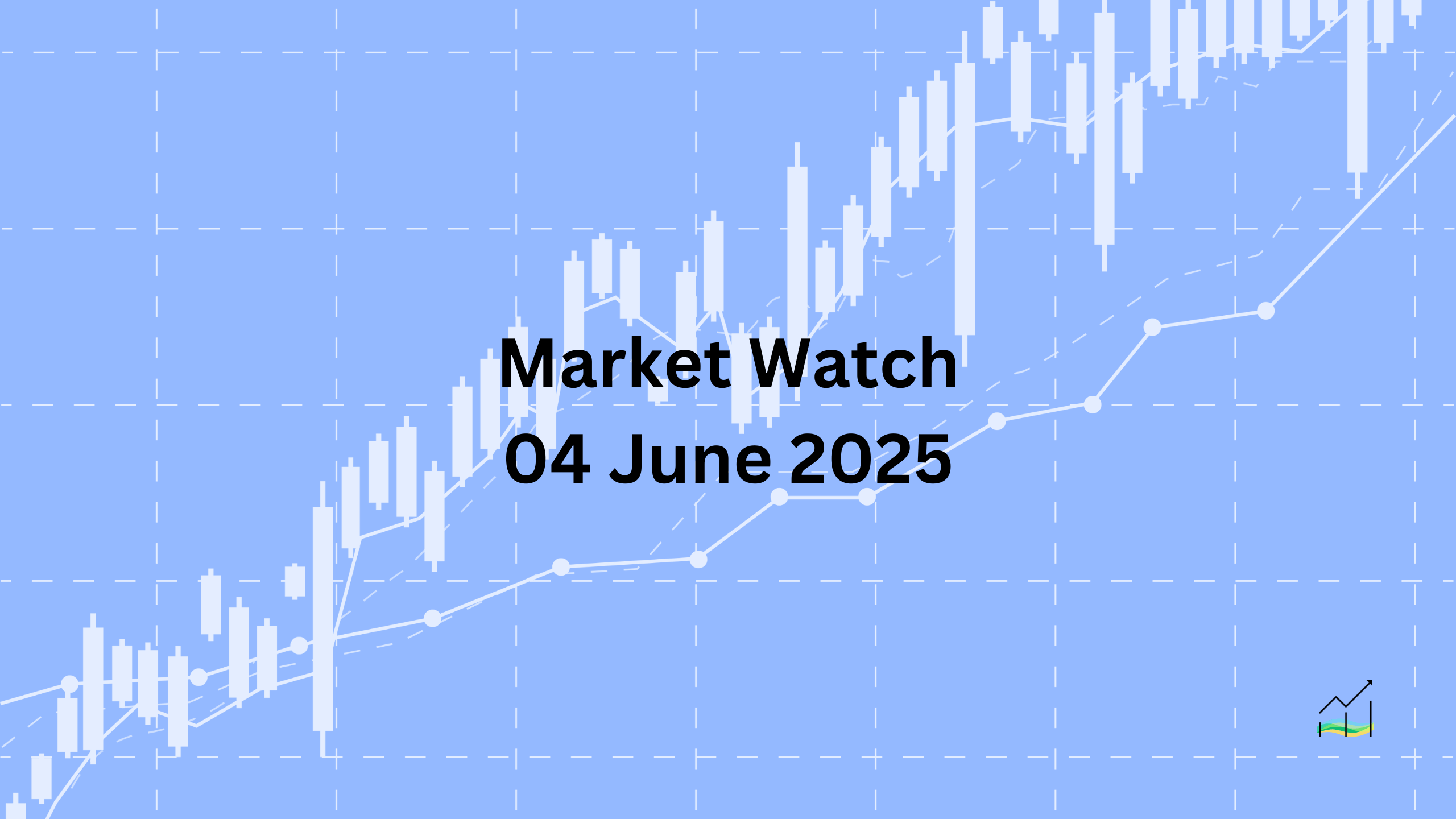04/06/2025 Market Watch

Markets Consolidate Ahead of Central Bank Decisions
Key Takeaways:
- USD weakened slightly after a strong JOLTS report, showing consolidation across major currencies.
- Final May PMI figures showed improvement from initial estimates.
- BoC likely to hold rates steady amid solid CPI and GDP data, but further cuts remain likely.
- ECB is expected to cut rates by 25 bps, with a pause in focus as neutral levels approach.
- Global equities are mostly higher, supported by gains in US and Asia.
- Yields are trending upward across major markets, including US, Europe, and Japan.
- Gold is steady; oil remains range-bound after a recent push higher.
The US dollar showed some strength following a stronger-than-expected JOLTS report but has since weakened against most G10 and emerging market currencies. This signals a broader tone of consolidation in the currency markets. At the same time, revised final May PMIs across various regions reflect a more positive tone than earlier flash estimates, as the impact of April's US tariffs begins to ease.
Today’s focus shifts to the Bank of Canada, which is widely expected to leave rates unchanged due to firm core inflation and solid Q1 GDP growth. However, the broader easing trend remains intact, and future rate cuts are still likely. Tomorrow, the European Central Bank is expected to deliver a 25-basis point rate cut. With the policy rate nearing neutral levels, attention may shift to a possible pause to assess the impact of previous easing moves.
Equity markets are responding positively to US gains, with most Asia Pacific indices in the green, led by a strong rally in Taiwan. European stocks are also higher, while US futures suggest continued strength. Bond yields are ticking upward across major regions, with notable increases in Japanese long-term yields and a slight rise in the US 10-year Treasury, now hovering around 4.46%. Commodities are relatively stable, with gold holding within its previous range and oil trading in a narrow band after reaching recent highs.
United States of America
Overview
The US dollar regained strength after slipping to a six-week low early Tuesday in Asia, recovering to a session high following a better-than-expected rise in job openings. However, the April JOLTS report offered a mixed picture—while job openings increased, layoffs were higher than anticipated, and the number of quits declined. The Dollar Index remains below Monday's high and is testing support near the 99.00 level during European hours.
Despite the attention on labor data, the Federal Reserve appears less reactive to survey-based indicators like the ISM services and final PMI reports. These will likely have minimal impact on policy direction. The Beige Book is due today and, although anecdotal, often holds weight in the Fed’s broader assessment. More emphasis is placed on hard labor market data this week, particularly the upcoming ADP employment estimate. Historically, ADP figures have shown varied alignment with BLS data, underestimating on average through April, but overestimating over the past year.
Economic Drivers
- April JOLTS report showed a rise in job openings, but also higher layoffs and fewer quits.
- Market expectations centre on labour data, especially nonfarm-related figures.
- Fed places less weight on surveys like ISM services and PMIs.
- The Beige Book may offer insight but is anecdotal in nature.
- Historical discrepancies between ADP and BLS job figures suggest uncertainty in projections.
Data and Events
- 04 June 2025: ADP Non-Farm Employment Change
- 04 June 2025: ISM Services PMI.
Price Action
- Dollar Index rebounded from 98.60 to near 99.35 after JOLTS data.
- Still trading below Monday’s high (~99.40), testing support near 99.00.
- Overall tone suggests consolidation within recent highs and lows.
Key Points:
- Dollar Index recovered after early weakness, helped by stronger job openings.
- JOLTS data mixed: more openings, but also more layoffs and fewer quits.
- Fed likely to overlook ISM and PMI data, focusing more on hard labour data.
- ADP job estimate will be closely watched for its predictive value.
- Price action reflects a consolidating dollar, with resistance near 99.40 and support around 99.00.
Australia
Overview
The Australian dollar continues to face strong resistance near the $0.6500 level, a zone it has struggled to break above since early last month. Despite a few short-lived moves, the currency has mostly traded within the $0.6400 range throughout May. Today’s session low was recorded after the release of weaker-than-expected GDP data for Q1 2025, with price action briefly hovering above $0.6450, where a significant batch of options is set to expire.
Australia’s final services and composite PMI figures were also released but had a limited impact, as attention remained fixed on the GDP report. The economy grew just 0.2% in the first quarter, half the pace expected by market consensus and notably slower than the 0.6% expansion in the previous quarter. The PMI readings reflect this softening trend, with the composite index averaging 50.8 in April and May, slightly below the 51.1 average for Q1. Markets are now looking ahead to tomorrow’s trade and household spending figures, which could provide further insight into domestic demand.
Economic Drivers
- Q1 GDP growth came in at 0.2%, well below forecasts and down from 0.6% in Q4 2024.
- PMI data suggests a gradual slowing in economic momentum.
- Composite PMI averaged 50.8 in April and May, lower than Q1’s 51.1.
- A smaller trade surplus is anticipated for April, along with a potential rebound in household spending.
Data and Events
- 04 June 2025: GDP.
Price Action
- AUD has largely remained in the $0.6400 range since early May.
- Brief decline today after weak GDP data, touching just above $0.6450.
- Option expiry at $0.6450 (A$625 million) influenced intraday support.
Key Points:
- Q1 GDP data confirmed slower growth, adding downside pressure on AUD.
- PMI data aligns with a mild slowdown in overall economic activity.
- Market awaits trade and spending data to gauge domestic strength.
- AUD remains range-bound, capped near $0.6500 and supported near $0.6450.
Canada
Overview
Canada faces increasing economic pressure from external and domestic forces. The recently announced doubling of US tariffs on Canadian steel and aluminum is expected to deepen the country's economic challenges. Even prior to this announcement, forecasts had already pointed to a likely economic contraction for the current and next quarters. With monetary policy operating on a lag, the Bank of Canada has limited immediate tools to offset these headwinds. However, it moved early during the easing cycle, reducing the overnight rate by 225 basis points to 2.75% since June of last year.
Although the full impact of past rate cuts has yet to materialise, recent data suggest resilience in some areas. Core inflation readings for April remained elevated, and Q1 GDP growth came in stronger than expected at 2.2% versus the 1.7% consensus. These figures provide the central bank with justification to pause its rate-cutting cycle at today’s meeting. Market expectations, as reflected in swaps pricing and recent economist surveys, now align around a likely hold.
Economic Drivers
- US has doubled tariffs on Canadian steel and aluminum, weighing on growth outlook.
- Canadian economy was already forecast to contract in Q2 and Q3.
- Bank of Canada previously frontloaded rate cuts, lowering the overnight rate by 225 basis points.
- April core inflation remained high, reinforcing concerns about persistent price pressures.
- Q1 2025 GDP growth was stronger than expected at 2.2%.
- Cumulative rate cuts may not have fully impacted the economy yet.
Data and Events
- 04 June 2025: BOC Rate Statement.
- 04 June 2025: Overnight Rate.
- 04 June 2025: BOC Press Conference.
Price Action
- USDCAD hit a seven-month low near CAD1.3675 on Monday before rebounding.
- The pair has stayed below Monday’s high (~CAD1.3745), with resistance near CAD1.3730.
- Current trading is contained within yesterday’s range, showing subdued volatility.
- Options totalling $960 million at CAD1.3750 are set to expire today.
Key Points:
- Canada likely to enter contraction, worsened by new US tariffs.
- BoC expected to pause after earlier aggressive easing.
- Strong Q1 GDP and firm core inflation support a wait-and-see stance.
- USDCAD remains range-bound below key resistance, with expiry pressure at CAD1.3750.
China
Overview
The offshore yuan has strengthened modestly against the US dollar in recent sessions, despite broader dollar strength and weaker-than-expected Chinese manufacturing data. On Monday, the dollar approached its 200-day moving average against the yuan, but then pulled back following a drop in the Caixin manufacturing PMI. The dollar slipped as low as CNH7.1830 before rebounding to around CNH7.1955. The latest reference rate from the PBOC was set at CNY7.1886, slightly higher than the previous day’s fix.
Markets are now awaiting the release of Caixin services and composite PMIs, which are expected to show modest improvement. However, optimism remains fragile as trade tensions re-emerge and container shipments to the US continue to decline. Without additional policy support, concerns remain over China’s ability to meet its 5% growth target for the year. Structural issues within the economy and the absence of significant new stimulus measures add to the uncertainty surrounding the country’s outlook.
Economic Drivers
- Caixin manufacturing PMI disappointed, raising concerns about industrial momentum.
- Trade pressures persist, with container shipments to the US hitting new lows.
- Re-emerging trade tensions continue to weigh on export outlook.
- Lack of substantial fiscal or monetary stimulus raises doubts over achieving the 5% growth target.
- Anticipation of slight improvement in services and composite PMIs.
Data and Events
No major economic releases are scheduled today.
Price Action
- USD/CNH retreated from the 200-day moving average near CNH7.2265.
- Declined to CNH7.1830 before recovering toward CNH7.1955.
- A break below CNH7.1800 could open the path toward the six-month low at CNH7.1615.
- PBOC fixed the yuan at CNY7.1886, slightly above the previous day’s level.
Key Points:
- Yuan appreciated despite weak manufacturing PMI and strong dollar backdrop.
- Container trade to the US remains under pressure, reflecting persistent external strain.
- Services and composite PMIs are expected to improve, but gains may be limited.
- Without stronger stimulus, meeting the 5% GDP target remains uncertain.
- Price action suggests cautious support for the yuan, with key levels in focus.
Europe
Overview
The euro came under pressure after failing to hold gains above the $1.14 level, retreating from a high near $1.1455 to around $1.1365. This pullback aligns with a retracement of recent gains from the late May low near $1.1210. Market sentiment remains cautious as large option expiries near $1.1450 add to resistance.
On the data front, final readings of the services and composite PMIs for May were revised slightly higher. The services PMI was upgraded to 49.7 from a preliminary 48.9, still below the 50 threshold and marking the first contractionary reading of the year. Meanwhile, the composite PMI came in at 50.2, slightly lower than April but remaining in expansion territory. These revisions may not significantly influence the European Central Bank's stance ahead of tomorrow’s policy meeting, where a 25 basis point rate cut is widely expected. The ECB is also expected to revise down its growth and inflation projections. Germany will release factory orders shortly before the ECB meeting, with expectations for a decline after a strong surge in March. This will be followed by industrial production and trade data later in the week, which may reflect the impact of slowing demand and tariff-related distortions.
Economic Drivers
- ECB places greater weight on PMI survey data relative to the Federal Reserve.
- May services PMI was revised up to 49.7, indicating contraction for the first time this year.
- Composite PMI revised to 50.2, still above the 50 mark but down from April.
- ECB is expected to cut rates by 25 basis points at the upcoming meeting.
- Growth and inflation forecasts are likely to be lowered by ECB staff.
- German factory orders expected to decline after strong March data, possibly boosted by pre-tariff activity.
Data and Events
- 04 June 2025: Eurozone Services PMI.
Price Action
- Euro fell from $1.1455 to $1.1365, retracing 38.2% of the recent rally.
- Struggling to reclaim ground above the $1.14 level.
- Option expiry of €1.3 billion at $1.1450 today is capping upside momentum.
Key Points:
- Euro weakened after failing to sustain gains above $1.14.
- PMI data showed slight revisions but suggest softening momentum.
- ECB expected to cut rates and downgrade economic forecasts.
- German data could confirm a slowdown in factory activity and trade.
- Option expiry at $1.1450 is limiting euro gains in the short term.
Japan
Overview
The Japanese yen weakened as the dollar rebounded from a five-day low near JPY142.40, climbing past the previous session’s high to reach almost JPY144.40 before losing momentum. Despite this short-term strength, the dollar struggled to hold gains and has since found support near JPY143.80. A drop back below the JPY143.25–50 zone could signal more consolidation in the current trend, rather than a shift toward a broader correction.
On the data front, markets showed little reaction to Japan’s PMI readings, which were revised modestly higher. The final services PMI for May came in at 51.0, slightly up from the initial estimate of 50.8 but still down from April’s 52.4. The composite PMI was revised from 49.8 to 50.2, just above the neutral threshold, reflecting a small recovery but still softer than earlier in the year. Looking ahead, April labor earnings data will be released tomorrow, with nominal wages expected to rise 2.6% year-over-year. However, real wages remain under pressure and are likely to post another annual decline.
Economic Drivers
- Japan’s final May services PMI was revised to 51.0, down from April but slightly above the flash estimate.
- Composite PMI improved to 50.2, reflecting marginal expansion but weaker than last year’s levels.
- Market reaction to PMI data remains minimal, as it holds limited influence on current market sentiment.
- April labor earnings are forecast to show higher nominal growth but continued real wage contraction.
Data and Events
No major economic releases are scheduled today.
Price Action
- USD/JPY rebounded from JPY142.40 to near JPY144.40 before fading.
- Resistance capped just above JPY144.15; support forming near JPY143.80.
- A drop below the JPY143.25–50 area could suggest a consolidative pattern.
Key Points:
- Dollar gained against yen but failed to sustain above JPY144.40.
- Revised PMIs show modest improvement but remain mixed in strength.
- Markets await wage data, with real income still under pressure.
- Price action points to consolidation rather than a new directional shift.
United Kingdom
Overview
Sterling remains within a tight range this week, showing signs of consolidation after holding above the $1.3500 level. Tuesday's session low was recorded just below this level during early US hours, but the pound has since stabilised and is trading slightly below $1.3550 in late European trading. Market behaviour suggests a constructive consolidation phase, with no immediate catalysts driving a breakout in either direction.
Final PMI data for May offered minor upside surprises but failed to materially shift the outlook. The services PMI was revised to 50.9 from the initial 50.2 estimate, rebounding from April’s 49.0 reading, which marked the lowest since early 2023. The composite PMI also saw an upward revision to 50.3 from 49.4, reflecting a return to modest expansion. Despite the improvement, both readings remain well below levels seen last year. The interest rate outlook remains stable, with markets assigning virtually no probability of a rate cut at the June 19 Bank of England meeting. A full rate cut is not priced in until November.
Economic Drivers
- May services PMI revised to 50.9, rebounding from April’s 49.0.
- Composite PMI improved to 50.3, returning to slight expansion.
- Upward revisions in both services and manufacturing PMIs suggest stabilisation.
- Swaps market sees no near-term BoE rate cut, with full cut expectations pushed to November.
Data and Events
- 04 June 2025: Final Services PMI.
Price Action
- GBP/USD held within Monday’s range, showing constructive consolidation.
- Session low near $1.3500 acted as support; resistance near $1.3550 remains intact.
- Price action suggests a neutral tone with limited directional bias.
Key Points:
- Sterling consolidates within a tight range, showing resilience above $1.3500.
- PMI data revised higher, signalling modest recovery in economic momentum.
- BoE rate expectations remain unchanged, with no cut seen until November.
- Price action reflects a stabilising market with low volatility.
© 2025 SKONE Enterprise (003319453-V). All rights reserved.
The content on this site is for informational purposes only and does not constitute financial advice.


